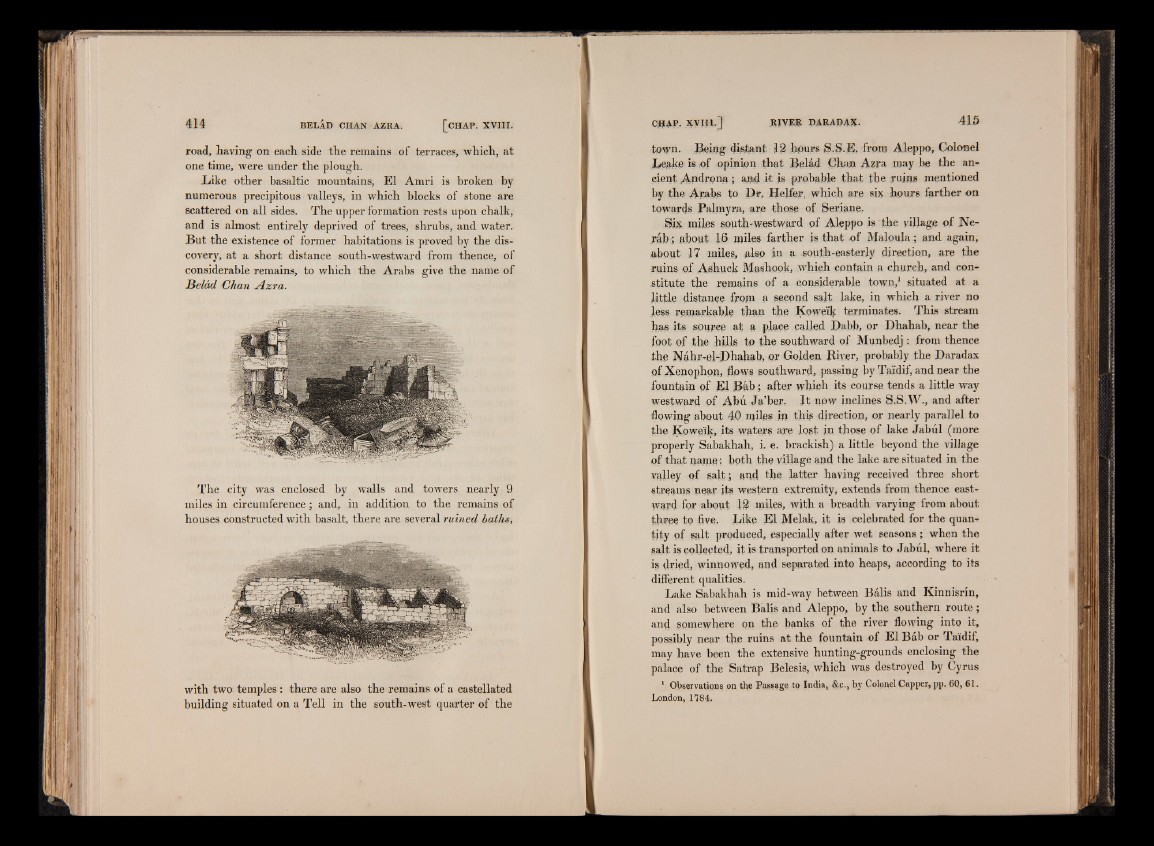
road, having on each side the remains of terraces, which, at
one time, were under the plough.
Like other basaltic mountains, El Amri is broken by
numerous precipitous valleys, in which blocks of stone are
scattered on all sides. The upper formation rests upon chalk,
and is almost entirely deprived of trees, shrubs, and water.
But the existence of former habitations is proved by the discovery,
at a short distance south-westward from thence, of
considerable remains, to which the Arabs give the name of
Belad Chan Azra.
The city was enclosed by walls and towers nearly 9
miles in circumference; and, in addition to the remains of
houses constructed with basalt, there are several ruined baths,
with two temples : there are also the remains of a castellated
building situated on a Tell in the south-west quarter of the
town. Being distant 12 hours S.S.E, from Aleppo, Colonel
Leslie is o f opinion that Belad Chan Azra may be the ancient
Aodrona; and it is probable that the ruins mentioned
by the Arabs to Dr, Heifer; which are six hours farther on
towards Palmyra, are those of Seriane.
Six miles south-westward of Aleppo is ' the village of Ne-
rab; about lb miles farther is that of Maloula; and again,
about 17 miles, also in a south-easterly direction, are the
ruins of Ashuck Mashook, whieh contain a church, and constitute
the remains of a considerable town,1 situated at a
little distance from a seepnd salt lake, in which a river no
Jess remarkable than the Koweik terminates. This stream
has its source at a place called Dabb, or Dhahab, near the
foot of the hiUs to the southward of Munbedj : from thence
the bfahr-el-Phahab, or Golden Biver, probably the Daradax
pf Xenophon, flows southward, passing by Taidif, and near the
fountain of El Bab; after which its course tends a little way
westward of Abu Ja’ber, It now inclines S.S.W., and after
flowing about 49 miles in this direction, or nearly parallel to
the Koweik, its waters are lost in those of lake Jabul (more
properly Sabakhah, i. e. brackish) a little beyond the village
of that name ; both the village and the lake are situated in the
valley of salt; and the latter having received three short
streams near its western extremity, extends from thence eastward
for about 12 miles, with a breadth varying from about
three to five. Like El Melak, it is celebrated for the quantity
pf salt produced, especially after wet seasons; when the
salt is collected, it is transported on animals to Jabul, where it
is dried, winnowed, and separated into heaps, according to its
different qualities.
Lake Sabakhah is mid-way between Balis and Kinnisrin,
and also between Balis and Aleppo, by the southern route;
and somewhere on the hanks of the river flowing into it,
possibly near the ruins at the fountain of El Bab or Taidif,
may have been the extensive hunting-grounds enclosing the
palace of the Satrap Belesis, which was destroyed by Cyrus
1 Observations on the Passage to India, &c., by Colonel Capper, pp. 60, 61.
London, 1184.